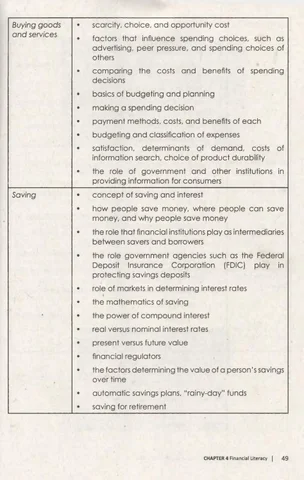Buying goods and services
Saving
•
scarcity, choice, and opportunity cost
•
factors that influence spending choices, such as advertising, peer pressure, and spending choices of others
•
comparing the costs and benefits of spending decisions
•
basics of budgeting and planning
•
making a spending decision
•
payment methods, costs, and benefits of each
•
budgeting and classification of expenses
•
satisfaction, determinants of demand, costs information search, choice of product durability
•
the role of government and other institutions in providing information for consumers
•
concept of saving and interest
•
how people save money, where people can save money, and why people save money
•
the role that financial institutions play as intermediaries between savers and borrowers
•
the role government agencies such as the Federal Deposit Insurance Corporation (FDIC) play in protecting savings deposits
•
role of markets in determining interest rates
•
the mathematics of saving
•
the power of compound interest
•
real versus nominal interest rates
•
present versus future value
•
financial regulators
•
the factors determining the value of a person’s savings over time
•
automatic savings plans, "rainy-day” funds
•
saving for retirement
CHAPTER 4 Financial Literacy |
of
49































